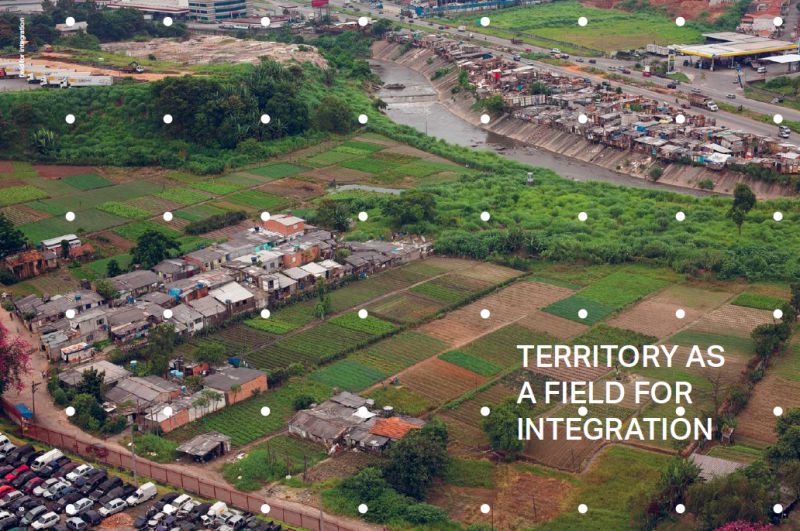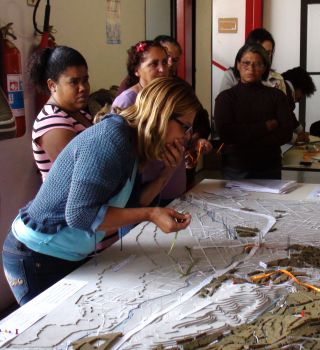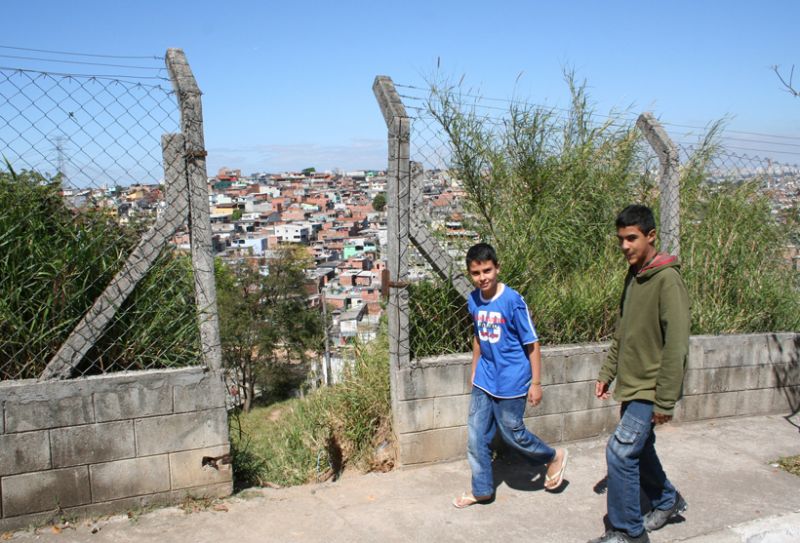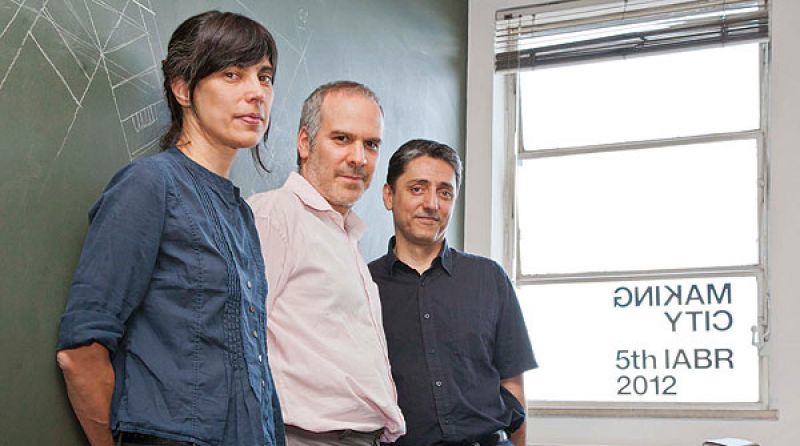Fernando de Mello Franco is one of the founding partners of MMBB Arquitetos in São Paulo, Brazil. He was a visiting professor at Harvard. De Mello Franco has strong ties with the IABR. In 2007 he won the Biennale Award with the project Watery Voids. In the 4th IABR, in 2009, he was one of the designers working on the project in the favela Paraisópolis that was set up as a collaboration of the IABR and SEHAB, the Municipality of São Paulo's Social Housing Department.
In 2012 he was a member of the international Curator Team of the 5th IABR: Making City and in that capacity he was the Atelier Master of the Atelier São Paulo, an initiative of the IABR and SEHAB in the context of the IABR Test Site São Paulo.
Fernando de Mello Franco was the Secretary of Urban Development of the City of São Paulo from 2013 until 2016, after which he became, among others, a Director of URBEM (Instituto de Urbanismo e Estudos para a Metrópole).

SMDU, São Paulo
The ongoing collaboration and exchange of expertise and ideas between the IABR and the Municipality of São Paulo in Brazil proved to be productive once again when, on December 1, in Mexico City, São Paulo’s mayor, Fernando Haddad, received the 2016 Grand Prize of the Mayors Challenge established and supported by Bloomberg Philantropies: 5 million dollars for the implementation of the plans that originated in the research by design-project Connect the Dots.

picture: Fabio Knoll
Exploring the complex relationships between urban development, infrastructure, small manufacturing and social housing, all against the background of the need to make city for people and to further social inclusivity, the Brazilian-Dutch team started with laying the groundwork for what was to become the first phase of IABR’s next economy-program.
When, on January 1st 2013, De Mello became São Paulo’s City Councilor for Urban Development, he took some of the ideas developed on the Test Site to the next stage, eventually leading to their integration in the city’s urban development policies. Connect the Dost was one of the projects in which these ideas came to fruition.
When the Mayors Challenge Grand Prize was announced, De Mello wrote “…IABR has been, once more, a valuable tool for me, since [the invitation to participate in] IABR–2016–THE NEXT ECONOMY was the trigger for the development of the initial research of Connect the Dots”.
Want to know more about the results of the ongoing collaboration between IABR and the city of São Paulo? Read the essay Connect the Dots that De Mello wrote for the catalog of IABR–2016–THE NEXT ECONOMY.
More on the project Connect the Dots itself in the PDF that you can download at the bottom of this page.
The opening of the exhibition THE NEXT ECONOMY on 23 April also marks the beginning of ten weeks of discussion and exchange about the future of the city. WHAT'S NEXT? starts on Saturday afternoon with an introduction by IABR-director George Brugmans, a speech by Rotterdam's mayor Ahmed Aboutaleb, and three panel discussions, guided by Maarten Hajer, on the three main themes of IABR–2016: the productive and inclusive city, the healthy and cooperative city, and the green sustainable city.
There is also a continuous program of presentations by guests of and participants in the IABR 2016.
1 pm approx: Panel 1: THE PRODUCTIVE AND INCLUSIVE CITY
In cities there is a renewed interest in a local manufacturing economy. New opportunities are provided by the emergence of smart technologies, the ambition to develop a circular economy, reshoring (bringing manufacturing back home), and an increasing public demand for (local) craftsmanship. How can spatial quality and the urban economy reinforce one another, and who creates and benefits from a productive city? And how do we connect new dynamics to the existing informal economy?
With, among others, Jeanne van Heeswijk (artist and founder of the Freehouse Foundation and the Afrikaanderwijk Cooperation in Rotterdam), Fernando de Mello Franco (architect, currently the City Councilor of Urban Development of São Paulo, and member of the Curator Team of the 5th IABR: Making City) and Daan Zandbelt (partner De Zwarte Hond and Lead Designer of the IABR–Atelier Rotterdam Productive City).
2:30 pm: Panel 2: THE HEALTHY AND COOPERATIVE CITY
Even in the Netherlands life expectancy between people living in different neighborhoods of the same city areas can differ up to 13 years. While people get older and care gets more expensive, retirement and nursing homes are closing down. This second panel is about the relationship between health and urban development. How do cities cope with the retreat of institutional care? Will we survive being left dependent on cooperation or should governments and health insurers reconsider their roles and take a share of the responsibility? And how can the healthy city in the Next Economy be healthy for everyone?
With, among others, Joachim Declerck (partner Architecture Workroom Brussels and Lead Designer of the IABR–Atelier Utrecht) and Pauline Meurs (Professor of Health Care Governance at Erasmus University Rotterdam and Chair of the Council for Health and Society) and Victor Everhardt (Alderman for Public Health and Deputy Mayor of the Municipality of Utrecht).
4 pm: Panel 3: THE GREEN AND SUSTAINABLE CITY
What needs to happen if we would be truly serious about the 2 degrees climate goal? The European climate objective – 80 to 95 percent reduction of greenhouse gas emissions in 2050 compared with 1990 – requires significant system changes, but it also opens up new economic vistas. Which spatial conditions would support such an economy? Is a climate neutral city really feasible, and how could design make a contribution? How to connect small-scale initiatives to large companies that are part of the old system? And is there something we could learn in this respect from Africa?
With, among others, Eglantina Gjermeni (Minister of Urban Development of Albania, and responsible for Atelier Albania), Nienke Homan (Regional Minister of Energy Transition and Environment of the Province of Groningen, and co-commissioner of the Atelier Groningen), Mark Swilling (member of UNEP’s International Resource Panel and Distinguished Professor in Sustainable Development at the University of Stellenbosch, Cape Town) and Dirk Sijmons (one of the founders of H+N+S Landschapsarchitecten, emeritus professor of Environmental Design at TU Delft and curator of IABR–2014–URBAN BY NATURE).
Saturday 23 April 2016
Time: 12 noon - 6 pm
Locatie: Fenixloods II, Paul Nijghkade 19, Rotterdam
Language: English
Reservation for the opening weekend is not possible, tickets are available at the box office.
Tickets for the panels and the Next Salon are available at the box office an hour before the start of the program. Please note that there is a limited number of seats available.
NEXT SALON #1 – INFORMAL BUT INVALUABLE
the added value of the informal economy
In many cities in the world the informal economy plays a crucial and locally often very valuable role. What can we learn from the resilience and creativity of local entrepreneurs who are not visible in the statistics and who, to economically survive, operate outside the space of regulations and administrative control? What are smart ways to link the informal to the formal economy? And what spatial conditions and planning strategies encourage these necessary economic activities?
In the first part of the Salon the host, Maarten Hajer, talks with the main guest Fernando de Mello Franco (architect, Secretary of Urban Development of São Paulo and member of the Curator Team of the 5th IABR: Making City), Kees Christiaanse (architect, professor at ETH Zürich and curator of the 4th IABR: Open City) and Roger Sherman (architect and professor at UCLA). Main topic is the added value of the informal economy in different cities all over the world, including South East Asia and South America.
After the entr'acte, the conversation continues and zooms in on the spatial and administrative conditions necessary to allow for a clever link between the formal and informal economies, and on what Western-European cities could learn in this aspect from the Global South. Hajer and De Mello Franco will be joined by Arbi Mazniku, deputy-mayor of Tirana, Albania, and other guests.
Sunday 24 April 2016
Time: 14:30 - 16 pm
Location: Fenixloods II, Paul Nijghkade 19, Rotterdam
Language English
Reservation for the opening weekend is not possible, tickets are available at the box office.
Tickets for the Next Salon are available at the box office an hour before the start of the program. Please note that there is a limited number of seats available.
On Sunday 24 April, Next Salon #1 will take place, the first in a series of four Sunday afternoon meetings that zoom in on current events that impact the debate about the Next Economy.

© George Brugmans
The collaboration with the Municipality of São Paulo started in 2008. It was the beginning of a four year long alliance between George Brugmans, director of the IABR, and Elisabete França, director of the Secretariá Municipal de Habitação (SEHAB), the Department of Social Housing of what is the biggest metro region in the Southern hemisphere and the economic heart of one of the world's most successful 'emerging economies', Brazil.
The first collaborative project focused on Paraisópolis, one of the largest favelas in São Paulo. Its 70.000 inhabitants are literally squeezed in by upscale apartment buildings.

picture by Tuco Vieira
The research team, coordinated from the Netherlands and Brazil, and led by 4th IABR Curator Kees Christiaanse, Maria Teresa Diniz (SEHAB) and Rainer Hehl (ETH Zurich), worked with the inhabitants, conducted design research and developed plans during workshops in Rotterdam, São Paulo and at the Swiss Federal Institute of Technology (ETH) Zurich – plans that were publicly discussed, presented at the Rotterdam biennale, exhibited in April and May 2010 in São Paulo and then in Rio de Janeiro, Recife, London, Milan, and Berlin, and subsequently realized. The Municipality of Sãõ Paulo started with the implementation in 2010.
The living environment of over 70,000 people is actually being improved, increasing their access opportunities to the formal economy in the process. Another outcome was that SEHAB adjusted its working methods as a result of the 'research by design' approach . Maria Teresa Diniz, Paraisópolis project manager at SEHAB, put it this way: "The collaboration with the IABR proved to be much more intensive and productive than a mere exchange of ideas. We discussed the role of architects and urban designers, how their work might contribute to a better life in the city, to an Open City, a much broader perspective, in other words. In the beginning we were not at all familiar with the IABR’s working model: a test site where the work is already in progress? How can you discuss a design that is in such an advanced stage of completion? When Paraisópolis became a laboratory for the Open City, however, it proved extremely fruitful to discuss the way we work with experts from other parts of the world. Our methods were examined, and this forced us to reconsider and adjust them."
Atelier São Paulo: the challenge in Cabuçu de Cima
As the projects developed by the IABR and SEHAB under the aegis of the 4th IABR: Open City for the Paraisópolis favela progressed from drawing board to exhibition the two parties decided to prolong their collaboration. Their primary objective, in the words of Elisabete França, SEHAB’s director, was ". . . to place the emphasis on the importance of urbanization projects for the so-called informal city, whereby the latter should be seen not as an exception but as an area that should be integrated into the total urban fabric."
The IABR appointed architect Fernando de Mello Franco, along with his partners at MMBB Arquitetos, Marta Moreira and Milton Braga, as local curator. De Mello’s work focuses on the relationship between the way São Paulo’s infrastructure, primarily oriented toward industrial production, has evolved over the past century and the role this has played and continues to play in the functioning of the city for its residents.
At De Mello’s initiative, the area of Cabuçu de Cima, on the north side of São Paulo, was selected as the Test Site. The area is representative, in the sense that it combines many typical urban problems and challenges – like informal urban development, serious water management problems, threatened ecological systems such as the Serra da Cantareira, the largest rainforest within an urban area in the world, and a deficient mobility network – even as it is positioned at the intersection of significant future developments. The Rodoanel, the new ring road, and its strategic position near the Guarhulos international airport mean that Cabuçu will become, even more than at present, the primary distribution centre for the northeast side of São Paulo, the side that connects this economic powerhouse with two other important players, Rio de Janeiro and Belo Horizonte.
How can the threats, the problems, the interests of the inhabitants and the socioeconomic opportunities be translated into one integral strategy? How can existing conditions serve as a strong basis for such a strategy? These were the challenges the Atelier faced in Cabuçu de Cima.
The Atelier therefore explored, in the words of De Mello, "...ways of reconciling economic growth processes with pressure on the ecological system and the genuine desires of the population. This agenda must now be taken up by a metropolis that is in a delicate moment of transition: for São Paulo the time has come to consider new ways of making city."

© George Brugmans
Test Site São Paulo was a collaborative project of IABR and SEHAB São Paulo, under the responsibility of George Brugmans and Elisabete França.
Financial support from the Dutch Ministry of Infrastructure and the Environment made a temporary alliance between MMBB and the Dutch design office .FABRIC possible. .FABRIC developed a spatial strategy for Cabuçu de Cima to boost the area's fragile local economy - click here to see the film The City and The Forest
One of the first decisions of the newly elected mayor of São Paulo, Fernando Haddad, was to appoint the architect Fernando de Mello Franco as his Secretary for Urban Development. De Mello Franco is a member of the Curator Team of the 5th IABR: Making City.
De Mello Franco will be responsible for effecting one of Mayor Haddad's main campaign promises, the Arco do Futuro, the bridge to the future, the city's main development plan.
We are delighted to note that it is to be an architect who will actually be in charge of 'making city' in the biggest metropolis of the southern hemisphere.

from left to right: Marta Moreira, Milton Braga and Fernando de Mello Franco
picture: George Brugmans
Fernando De Mello Franco is one of the founding partners of MMBB Arquitetos in São Paulo and he is the curator of the Instituto Urbem. He was a visiting professor at Harvard. De Mello Franco has strong ties with the IABR. In 2007 he won the Biennale Award with the project Watery Voids. In the 4th IABR, in 2009, he was one of the designers working on the project in the favela Paraisópolis that was set up as a collaboration of the IABR and SEHAB, the Municipality of São Paulo's Social Housing Department.
Fernando de Mello Franco was a member of the international Curator Team of the 5th IABR: Making City and in that capacity he was the Atelier Master of the Atelier São Paulo, an initiative of the IABR and SEHAB in the context of the IABR Test Site São Paulo.
Curator Team
Asu Aksoy (Istanbul, TR), George Brugmans (Amsterdam, NL), Joachim Declerck (Brussels, BE), Fernando de Mello Franco (São Paulo, BR), Henk Ovink (The Hague, NL) and ZUS (Rotterdam, NL)

Curator Team 5th IABR
(from left to right: Brugmans, Aksoy, Declerck, Ovink, Koreman, De Mello Franco and Van Boxel)
Director
George Brugmans
Opening
19 April 2012, by Melanie Schultz van Hagen, minister of Infrastructure and the Environment, and Ahmed Aboutaleb, mayor of Rotterdam
Exhibitions
Making City
curator: Joachim Declerck
location: NAI, Rotterdam
Smart Cities - Parallel Cases 2
curators: Stefan Bendiks, Rogier van den Berg, Matthijs de Boer, Annet Ritsema
location: NAI, Rotterdam
Test Site Rotterdam
curator: ZUS (Elma van Boxel, Kristian Koreman)
location: Rotterdam Central District
Making Douala 2007 - 2013
curators: Marilyn Douala-Bell, Didier Schaub, Xandra Nibbeling, Kamiel Verschuren, Lucas Grandin
location: RiverClub Gallery, Rotterdam
Design as Politics
curator: Wouter van Stiphout
location: Mini Mall, Hofbogen, Rotterdam
Making Almere
curator: INTI
location: Belfort 13, Almere
Making City São Paulo, Da Cidade Informal aos Novos Bairros
curator: Elisabete França
location: Museu da Casa Brasileira, São Paulo
Making City Istanbul
curators: Asu Aksoy, George Brugmans, Joachim Declerck
location: Istanbul Modern, Istanbul, main exhibition 1st Istanbul Design Biennale
April 2012 – December 2012
133.600 visitors
Events
Urban Summit
51 lectures, debates, screenings, workshops and other events
VPRO: The City Forever
a full week of television and radio programming watched and tuned into by 2,8 million people
projectmanagement: Wim Schepens
publications and documentaries
Making City, 5e IABR 2012, Catalogue
George Brugmans, Jan Willem Petersen (ed)
2012, IABR
The Future Agenda
George Brugmans, Joachim Declerck, Henk Ovink
in: Megacities, Exploring a Sustainable Future
Steef Buijs, Wendy Tan, Devisari Tunas (ed)
2010, 010 Publishers
Rotterdam - People Make the Inner City
2012, Municipality of Rotterdam
Designing Olympics
Daniël de Groot, Willemieke Hornis, Elien Wierenga (ed)
2012, 010 Publishers
Olympic Cities
XLM Architecture Research Urbanism
2012, XLM
The Netherlands in Projects
Jelte Boeijenga, Paul Gerretsen, Elien Wierenga (ed)
2013, 010 Publishers
Sürdürülebilir Kent Yapmak/Making a Sustainable City: The Arnavutköy Approach
Asu Aksoy, Gülnur Kadayifçi, Hülya Yalçin (ed)
2012, Municipality of Arnavutköy & IABR
Sürdürülebilir Kent Yapmak/Perspectives from Turkey on Sustainable City Making
Asu Aksoy, Gülnur Kadayifçi, Hülya Yalçin (ed)
2012, Municipality of Arnavutköy & IABR
900 Km Nile City: A Strategic Design for a Rural Metropolis
Pier Paolo Tamburelli, Oliver Thill (ed)
2009, The Berlage Institute Research Report No. 31
Making Douala 2007 - 2013
Xandra Nibbeling, Kamiel Verschuren (ed)
2012, Doual'Art & ICU Art Projects Foundation
The River Cities Project: IABR Catalogue
Michael Speaks, Angela Torchio (ed)
2012, University of Kentucky
Typology. Hong Kong, Rome, New York, Buenos Aires
Emanuel Christ, Christoph Gantenbein (red)
2012, ETH Zürich
Posconflicto Laboratory: Making City + Productive Housing Programm in Guatemala & Central America
Urbanistica–Taller del Espacio Publico, Municipality of Guatemala & Asociacion Centroamericana Taller de Arquitectura
2012
Making Cities
director: Alexander Oey
VPRO Tegenlicht in coproduction with IABR

